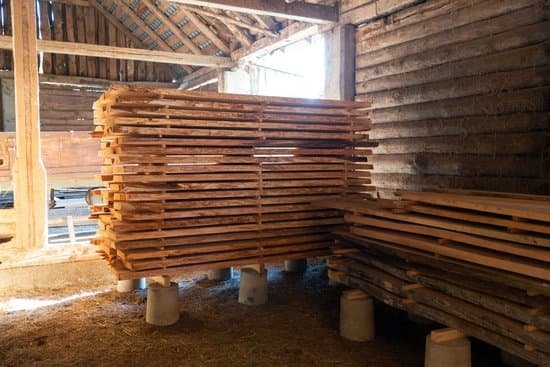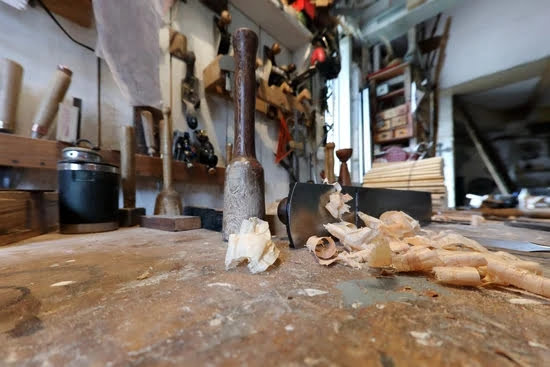Choosing the right hand tool woodworking project is essential for any woodworker, whether you are a beginner or have years of experience in the craft. The project you select can significantly impact your skills development and overall enjoyment of woodworking. In this article, we will explore the importance of carefully choosing your next woodworking project and how it can enhance your skills and level of satisfaction.
When it comes to woodworking, not all projects are created equal. Each project presents different challenges, techniques, and levels of complexity. By selecting the right project for your skill level and interest, you can ensure a smooth learning curve and avoid becoming overwhelmed or disheartened by an overly ambitious endeavor.
Furthermore, choosing the right hand tool woodworking project allows you to focus on an area that truly inspires you. Whether it’s crafting intricate furniture pieces or building small wooden crafts, selecting a project aligned with your interests will increase your motivation and enjoyment throughout the process.
With these considerations in mind, let us delve deeper into assessing your skills and experience, identifying your goals and interests, evaluating available time and resources, researching for inspiration, and ultimately selecting a suitable hand tool woodworking project based on your criteria. By following these steps, you can embark on your next woodworking journey with confidence and maximize your growth as a woodworker.
Assessing your woodworking skills and experience
When choosing your next hand tool woodworking project, it is essential to honestly assess your current skill level and experience with hand tools. Evaluating your capabilities will help ensure that you select a project that aligns with your abilities, allowing for growth and improvement while still being manageable.
One way to assess your woodworking skills is by considering the complexity and difficulty level of potential projects. If you are new to woodworking or have limited experience with hand tools, it might be wise to start with simpler projects that focus on fundamental techniques. This could include small-scale projects like picture frames or cutting boards where you can practice basic joinery techniques like dovetail or mortise and tenon joints.
On the other hand, if you have more advanced skills in woodworking, you may be ready to tackle more complex projects. These could involve intricate joinery methods, carving details, or working with more challenging materials. Assessing your skill level accurately will help ensure that you choose a project that provides the right level of challenge without overwhelming or frustrating you.
Consider using the following checklist when assessing your woodworking skills and experience:
- Identify the types of joinery techniques you are familiar with, such as dovetails, rabbets, or box joints.
- Evaluate your proficiency in using various hand tools like chisels, planes, and saws.
- Reflect on any previous projects you have completed successfully.
- Consider any specialized skills or areas of expertise you possess.
Taking the time to assess your woodworking skills and experience will aid in selecting a project that allows for growth while ensuring a satisfying and enjoyable woodworking journey overall.
Assessing Your Woodworking Skills
- List the joinery techniques you are familiar with
- Evaluate proficiency in using various hand tools
- Reflect on successful completion of previous projects
- Consider specialized skills or areas of expertise
Identifying your woodworking goals and interests
When choosing your next hand tool woodworking project, it is important to consider your own goals and interests. By determining what type of projects you are most passionate about, you can ensure that you will enjoy the process and stay motivated throughout the project. Here are some steps to help you identify your woodworking goals and interests:
- Determine what type of hand tool woodworking projects you are most passionate about: Consider what types of projects bring you the most joy and satisfaction. Are you interested in building furniture, carving intricate designs, or creating functional items for your home? Identifying your passions will help narrow down the options and focus on projects that truly speak to your interests.
- Set specific goals and objectives for your next project: Once you have identified your woodworking interests, it’s important to set specific goals for your next project. These goals could include learning a new technique, improving a specific skill, or completing a certain type of project within a certain timeframe. Setting clear objectives will give you something to work towards and help keep you motivated.
- Consider the level of challenge you are looking for: Some woodworkers thrive on challenging themselves with complex and intricate projects, while others prefer simple and straightforward designs. Think about how much challenge you want in your next project and choose accordingly. Remember that taking on a more difficult project can be an opportunity for growth, but it is also important not to overwhelm yourself if you are still building up your skills.
By identifying your woodworking goals and interests, you can select a project that aligns with what truly excites you. This will not only make the process more enjoyable but also give meaning and purpose to each piece you create. Whether it’s building a piece of furniture or carving a decorative item, choosing projects that resonate with your passions will enhance both your skills as a woodworker and overall enjoyment in the craft.
Considering available time and resources
Assessing the available time and resources for a woodworking project is a crucial step in choosing your next hand tool woodworking project. By considering these factors, you can ensure that you have the necessary tools, materials, and time to complete your project successfully.
When assessing the amount of time you can dedicate to your woodworking project, it is important to be realistic and consider any other commitments or responsibilities you may have. Woodworking projects can vary greatly in terms of their complexity and the time required to complete them. For example, a small jewelry box may take less time compared to building a full-sized dining table. It is essential to choose a project that fits within your available timeframe.
In addition to considering time constraints, evaluating the tools and materials you have on hand is equally important. Take inventory of your current woodworking tools and determine if you have everything you need for your desired project. Consider whether any additional tools or materials need to be purchased or borrowed. This evaluation will help ensure that you are well-prepared before starting your project.
| Considerations | Potential Questions |
|---|---|
| Time availability | – How many hours per week can I dedicate to woodworking? |
| Tool inventory | – Do I have all the necessary tools for this project? |
| Material availability | – Do I have enough wood/materials for this project? |
| Budget | – Can I afford any additional tools or materials required? |
By carefully considering available time and resources, you can ensure that you choose a hand tool woodworking project that is realistic and achievable within your means. Taking these factors into account will set you up for success and enhance your overall woodworking experience.
Evaluating project size and scope
When choosing your next hand tool woodworking project, it is crucial to consider the size and scope of the project. The scale of a project can greatly impact the time commitment, level of detail required, and the amount of space needed for its completion. Evaluating project size and scope will ensure that you select a project that aligns with your preferences and available resources.
Determining the scale of the project that suits your preferences and available workspace is an important factor to consider. If you have limited space, it may not be feasible to take on a large-scale project that requires extensive room for assembly or storage. On the other hand, if you have ample space, you may have more flexibility in choosing a larger project.
The time commitment required for different project sizes should also be taken into account. Some projects can be completed in a few hours or days, while others may take weeks or even months to finish. Assessing the amount of time you can dedicate to your woodworking project will help you choose a project that fits well within your schedule.
Additionally, considering the level of detail required for different projects is essential. Some projects may involve intricate joinery or complex design elements that require advanced woodworking techniques. If you are a beginner or have limited experience with hand tools, it may be more suitable to start with a smaller scale project that allows for practicing basic techniques before moving on to more challenging ones.
By evaluating the size and scope of potential projects, you can make an informed decision about which one suits your preferences, available workspace, and skill level. This will help ensure a successful woodworking experience and increase satisfaction with the final result.
| Factors | Considerations |
|---|---|
| Available workspace | Determine if your workspace can accommodate larger projects. |
| Time commitment | Assess how much time you can dedicate to the project. |
| Level of detail | Evaluate if your woodworking skills are suitable for the level of detail required. |
Researching and seeking inspiration
Exploring Various Sources of Inspiration
One way to gather inspiration for your next woodworking project is by exploring books and magazines dedicated to the craft. These resources often feature detailed plans, step-by-step instructions, and beautiful photographs that can spark your creativity. Additionally, online platforms such as woodworking forums and social media groups provide opportunities to connect with fellow woodworkers and share ideas.
Finding Project Ideas That Suit You
When seeking inspiration for your hand tool woodworking project, it’s important to consider what types of projects you are most passionate about. Perhaps you enjoy crafting small intricate pieces or prefer larger furniture items. Identifying your interests will help narrow down the vast array of potential projects available.
Once you have determined your interests, it can be helpful to set specific goals and objectives for your next project. Do you want to challenge yourself by trying a new technique or create a functional piece for your home? By clarifying what you hope to achieve with your woodworking project, you will be better equipped to find suitable ideas during the research process.
Making an Informed Decision
After researching and gathering inspiration from various sources, it’s time to select a suitable project based on your criteria. This involves carefully analyzing potential projects while considering factors such as skill level, available resources, time constraints, and personal goals. By conducting this analysis, you can narrow down your options and make an informed decision that aligns with both your abilities and aspirations.
Selecting a suitable project based on your criteria
After assessing your skills, considering your goals, and evaluating your available time and resources, it’s time to select a suitable hand tool woodworking project that aligns with your criteria. This step is crucial as it ensures that you embark on a project that you can successfully complete and enjoy. Here are some tips to help you in this process.
Conducting a careful analysis of potential projects
Once you have identified your criteria, it’s important to conduct a thorough analysis of potential projects. Take into account factors such as complexity, required tools and materials, and the level of detail involved. Consider how each project aligns with your skills, interests, and goals. Look for projects that challenge you just enough to help you grow but are still within reach of your current skill level.
Narrowing down your options
After analyzing different projects, start narrowing down your options. Make a shortlist of two or three projects that meet most, if not all, of your criteria. Compare each project against one another in terms of their complexity, time commitment, required resources, and alignment with your goals and interests. This will help you make an informed decision about which project is the best fit for you.
Making an informed decision
Once you have narrowed down your options, it’s time to make a decision. Consider all the factors you have analyzed so far and trust your instincts. Pick the project that excites you the most while still being manageable within your current skill set and available resources. Remember that woodworking should be an enjoyable experience, so choose a project that inspires and motivates you.
By selecting a suitable hand tool woodworking project based on your criteria, you set yourself up for success and enjoyment throughout the process. It allows you to grow as a woodworker while staying motivated every step of the way. Take the time to thoroughly analyze potential projects, narrow down your options, and make an informed decision that aligns with your skills, goals, and interests. This thoughtful selection process will ensure a rewarding woodworking journey.
Reviewing advanced techniques and challenges
Once you have narrowed down your options and selected a potential hand tool woodworking project, it is important to take the time to review any advanced techniques and challenges that you may encounter along the way. By doing this, you can better prepare yourself mentally and physically for the project ahead.
Firstly, it is crucial to identify any specific techniques that may be required for your chosen project. This could include joinery methods such as dovetail joints or mortise and tenon joints, as well as carving or shaping techniques. Research these techniques thoroughly and consider seeking guidance from experienced woodworkers who have already mastered them. By understanding the advanced techniques needed, you will be able to build your skills and achieve a higher level of craftsmanship.
Furthermore, it is important to anticipate any potential challenges that may arise during the project. This could include issues with wood movement, working with challenging materials, or using tools in unconventional ways. By identifying these challenges beforehand, you can strategize how to overcome them and avoid any unnecessary setbacks. Consider consulting woodworking forums or online communities where fellow woodworkers may share their experiences and offer advice on how to navigate these hurdles.
Lastly, embrace the opportunity to learn new skills during your chosen project. It is through tackling more complex projects that we grow as woodworkers. Embrace the challenge and be open to acquiring new knowledge and skills along the way. Give yourself permission to make mistakes and learn from them. Remember that true mastery comes with experience, so don’t be discouraged if things don’t go perfectly on your first attempt.
Conclusion
In conclusion, choosing the right hand tool woodworking project is essential for both beginners and experienced woodworkers. By carefully selecting your next project, you can enhance your woodworking skills and increase your enjoyment of the craft. Assessing your current skill level and experience, identifying your goals and interests, considering available time and resources, evaluating project size and scope, researching for inspiration, and reviewing potential challenges will help you make an informed decision.
When choosing a woodworking project, it is crucial to evaluate your current skill level and experience with hand tools. Selecting a project that matches your abilities will ensure that you can successfully complete it and continue to develop your woodworking skills. Additionally, considering the complexity and difficulty level of potential projects will prevent you from feeling overwhelmed or frustrated.
It is also important to identify your woodworking goals and interests. By determining what type of hand tool woodworking projects you are most passionate about, you can find projects that align with your personal preferences and keep yourself motivated throughout the process. Setting specific goals and objectives for your next project will provide you with a sense of direction and purpose.
Furthermore, considering available time and resources is key when choosing a woodworking project. Assessing how much time you can dedicate to the project will help you select one that fits into your schedule. Evaluating the tools and materials you have on hand, as well as any additional resources required, will allow you to plan ahead and avoid any unexpected obstacles.
By evaluating project size and scope, you can find one that suits both your preferences and available workspace. Determining the time commitment needed for different sizes of projects as well as the level of detail required will give you an idea of what to expect during the construction process.
Researching various sources of inspiration such as books, magazines, online platforms, and participating in woodworking communities can provide you with a wealth of ideas that align with your skills, interests, and aesthetic preferences. Exploring these sources will expose you to new techniques and designs that can inspire you to create unique and beautiful handcrafted pieces.
Finally, after conducting a careful analysis of potential projects based on your skills, interests, resources, and goals, it is time to make an informed decision. Narrow down your options and choose a project that excites you and challenges you to expand your abilities. By preparing yourself to learn new skills and overcome potential obstacles, you will be ready to embark on your next woodworking journey with confidence.
Frequently Asked Questions
What woodworking project is most profitable?
When it comes to profitable woodworking projects, there are several options to consider. One particularly lucrative project is furniture making. Crafting high-quality, unique furniture pieces such as tables, chairs, or beds can yield significant returns due to the value associated with handmade furniture. Another profitable woodworking project is cabinetry work.
Custom-made cabinets for kitchens, bathrooms, or storage spaces are always in demand. Additionally, wooden crafts and decorative pieces have a strong market appeal, especially if they showcase intricate details and craftsmanship. These could include items like cutting boards, jewelry boxes, or picture frames that can be sold online or at craft fairs.
What are 4 basic skills woodworkers should have?
Woodworkers should possess several basic skills to excel in their craft. First and foremost, mastering woodworking tools is essential. Understanding how to properly use saws, drills, chisels, and other tools ensures accurate cuts and precise shaping of wood pieces. Secondly, knowledge of different joinery techniques is crucial.
Woodworkers should be proficient in creating various types of joints such as butt joints, mortise and tenon joints, dovetail joints, and others to enhance the strength and stability of their projects. Measurement and math skills are also important as they aid in accurately calculating materials needed and ensuring precise fitment during assembly. Finally, having a comprehensive understanding of different types of wood species helps woodworkers choose the right material for each project based on its characteristics such as grain pattern, hardness, durability, and appearance.
What easy woodworking projects sell?
Easy woodworking projects that sell well often cater to a broad range of buyers seeking both functionality and aesthetics on a budget. One such project is building simple yet attractive shelves that can be used for storage or display purposes in homes or offices. Wooden planters are another popular option as they provide an easy way for people to incorporate plants into their indoor or outdoor spaces without taking up too much room or requiring significant maintenance efforts.
Additionally, small wooden kitchen utensils like spoons or spatulas are simple to make and can be marketed as eco-friendly alternatives to plastic utensils. Lastly, personalized wooden signs or name plaques tend to attract buyers looking for customized home decor items, making them a profitable option as well.

Hi everyone! I’m a woodworker and blogger, and this is my woodworking blog. In my blog, I share tips and tricks for woodworkers of all skill levels, as well as project ideas that you can try yourself.





